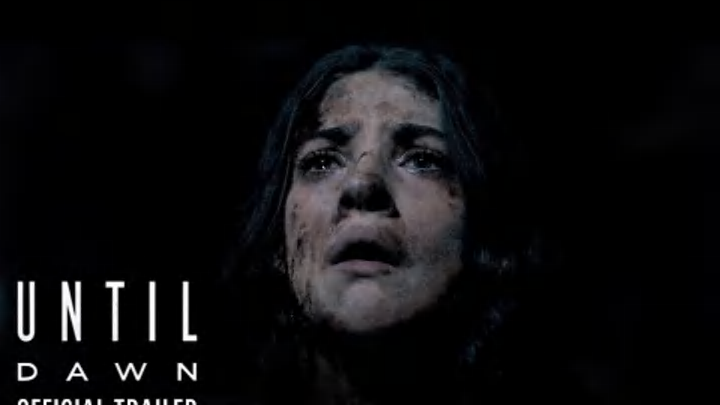Until Dawn is the latest video game adaptation of the same name from PlayStation Productions. The studio recently found success with the HBO series The Last of Us, headed by original game director Neil Druckmann and Chernobyl creator Craig Mazin. Until Dawn is helmed by Shazam! and Lights Out director David F. Sandberg. Despite straying from the game’s story, this adaptation by writers Blair Butler and Gary Dauberman is a serviceable adaptation.
Writers Butler and Dauberman use the same skeleton as the game but take liberties to build more likeable characters and add to the lore of the world. Fans should not expect a one-to-one adaptation, instead, something that feels similar in tone to the original work.
Until Dawn is packed with Easter eggs and references
Clover (Ella Rubin) is searching for her missing sister, Melanie (Maia Mitchell), and brings her friends, Max (Michael Cimino), Megan (Ji-young Yoo), Nina (Odessa A’zion), and Abe (Belmont Cameli) along to retrace her last steps in the hopes of finding her. They wind up in a paranormal, time-looping cabin where they discover new horrors each night including inhuman flesh-eaters known as wendigos. They trauma bond while accepting that some things are out of their control and others are well within.
Sandberg’s movie is embedded with Easter eggs and references to the original 2015 game, but die-hard fans might be disappointed without the one-to-one recreation. Instead, Sandberg delivers the semblance of playing the game while avoiding feeling repetitive. The video game emphasizes decision-making as it opens with a note about the butterfly effect. The film reflects this as it makes use of the increasingly popular time-loop in which the characters fail to survive the night over and over in the hopes of getting the good ending.
Trailer for the original release of Until Dawn from PlayStation below:
Sandberg’s use of the time loop is to deliver a heavy-handed message about dealing with mental health issues. Frequently, the characters state, “you get through tough s*** by sticking together,” also, “you don’t survive by sitting still.” He emphasizes the need to actively combat these issues instead of just escaping them. The way these characters finally come to understand this principle is at the cost of dying over and over until they figure out how to not just run from the monsters but to retaliate.
The themes of Sandberg’s Until Dawn reach only a surface level allegory for depression that, while feeling genuine, left me wanting more exploration. It could almost be a comfort movie for some experiencing this mental illness but all it has to offer is a reassuring pat on the back when it should’ve been a full embrace.
This wishy-washy approach to depicting Clover’s depression lessens the impact of the solution because we aren’t very familiar with her problem to begin with. We see only the culmination of Clover’s mental health struggles and only hear second hand about some severe instances through other characters. We don’t get to be with her when she struggles primarily but we are with her at the height of the issue.

While the characters feel more likeable than their video game counterparts, they feel just as hollow. Speaking cheesy lines of dialogue and performing cliches, understandably, they couldn’t bring anything memorable to these surely one-time characters. Performances were suitable but will not impress your memory.
As the characters slowly progress through the night, the dangers evolve with them, keeping things interesting and challenging. (This lead to my favorite death in the movie which involves spontaneous combustion which I found absolutely hilarious.) They learn more about the world and the multiple ways in which they are held captive, lending to the film’s lack of nuanced messaging. This leads me to believe the film is pointed towards high school teenagers who will get the most out of this film.
Sandberg’s Until Dawn is not a complete recreation of its source material but works well as an adaptation. Rather than making the film version of an already cinematic video game, he uses its core aspects to create something fresh for fans of the game. As a standalone horror film, it does enough to keep viewers’ attention for the short 103 minute runtime.
Until Dawn is now streaming on Netflix.
